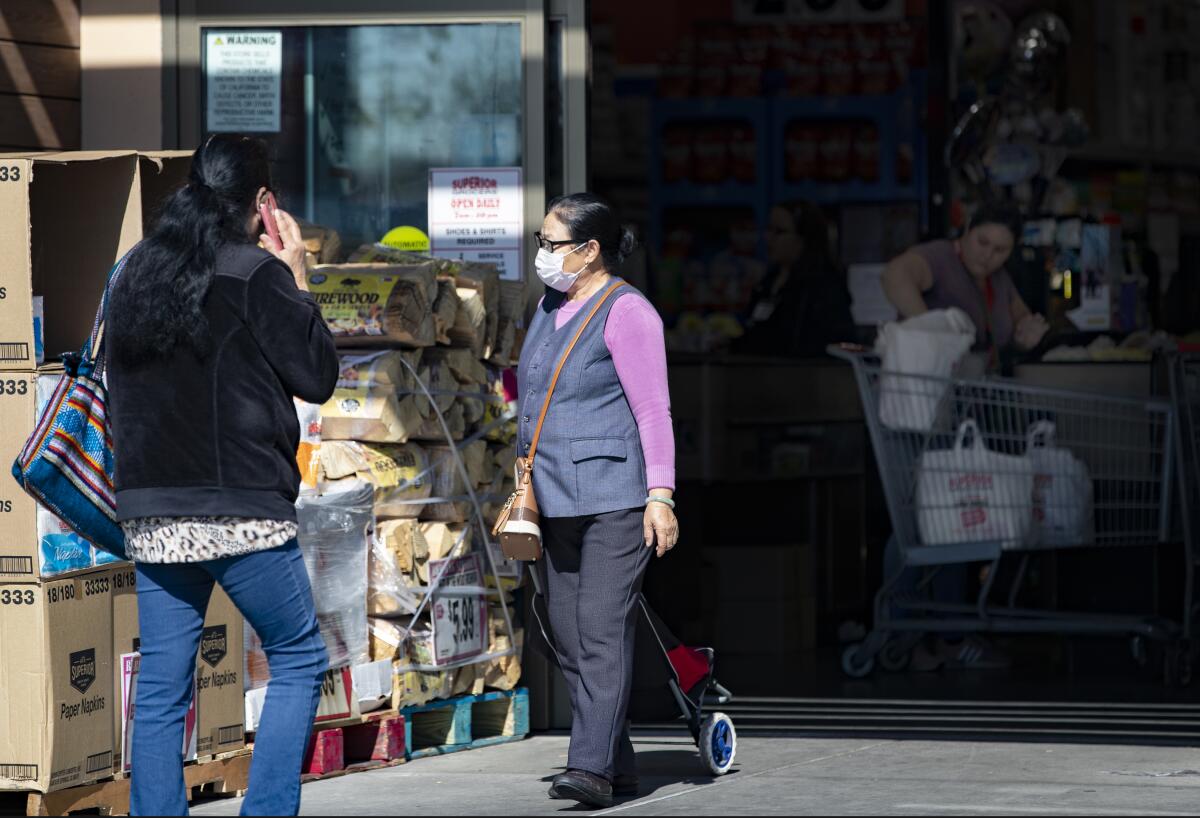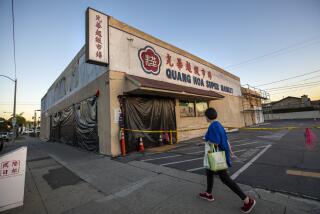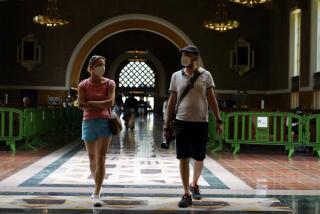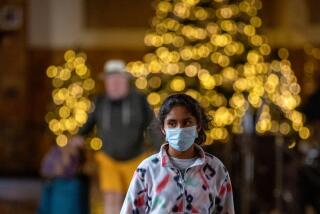Coronavirus sparks culture clash in the San Gabriel Valley

- Share via
Marta Ayala and Chong Taing, both Rosemead residents, couldn’t see the threat of the coronavirus more differently. You can see it on their faces.
While walking out of Superior Grocers supermarket in El Monte, Ayala’s face scrunched in annoyance as she spotted an Asian customer wearing a white medical mask coming from the opposite direction. Despite hearing about the fast-spreading illness, to the 64-year-old Mexican immigrant, the mask is an overreaction that just stokes alarm.
“I don’t believe in using masks and I don’t understand the need,” she said. “I know there’s a serious disease out there, but who has time to think about that?”
For the 39-year-old Taing, who wears a mask, the item makes as much sense as wearing long-sleeve shirts or sunglasses to protect from the sun. The masks aren’t just designed to protect the person wearing them from illness, but to protect others as well. It’s a common courtesy in a place he calls “the 626” — the area code-based nickname for the San Gabriel Valley.
“People wearing masks are being considerate,” Taing said. “Yes, we’re going to wash our hands, but we’re going to take extra precautions when we pick up our kids, do our shopping and go outside. We want to avoid getting sick as much as anyone, and at least we’re taking steps to do that.”
The virus, officially named COVID-19 by the World Health Organization, has seen cases worldwide rise to over 60,000 while the death toll has surpassed 1,300, as of Wednesday evening. In the U.S., there have been 15 confirmed cases with investigations ongoing in 41 states and territories.
Few places illustrate the parallel reactions to the illness the way the diverse San Gabriel Valley does. According to 2010 U.S. Census Bureau statistics, Latinos and Asians make up 46% and 28%, respectively, of the area’s 1.85 million residents. The two largest groups frequently shop, eat and send their children to the same schools. But how they have responded to the virus couldn’t be more different.
It is among the Asian population that concern over the disease manifests itself most visibly, with changing eating and shopping habits, the cancellation of large public events like Lunar New Year celebrations, avoidance of large family gatherings and the masks.
While the majority of people in the San Gabriel Valley do not wear the masks, those who do wear them — whether as protection against illnesses or pollution — are almost always of Asian descent. That can provoke misunderstanding and prejudice.
“Asking why people wear face masks... it’s a little bit like asking why do people wear hats in the U.S.,” said Emma Teng, a professor of Asian Civilizations at MIT.
Across the Pacific, masks have been worn for everything from disease control to anonymity during pro-democracy protests in Hong Kong, Teng said.
She said masks to protect against illness in Asia may have first emerged in Japan during the influenza pandemic in 1918 that lasted two years and claimed 50 million lives worldwide.
In more recent years, masks in Japan have served as a compromise for employees who didn’t want to miss work — or infect colleagues.
“I find it interesting that a lot of American people find it so strange,” Teng said. “Like for us, you’re sick and you wouldn’t blow your nose into a tissue and leave it on top of someone’s desk. This is just a courtesy.”
Still, Teng said she is selective about where she wears surgical masks. During a recent trip to Taiwan, she wore one, particularly while taking public transportation. But in the U.S., including at her job at MIT, she often refrains from wearing a mask.
“I believe it would make the students very nervous if they saw their teacher wearing a face mask,” Teng said. “So, I think there are some deep cultural differences.”
In the San Gabriel Valley, Latinos and Asians often work in the same places. Many of the Chinese and Vietnamese restaurants that line streets such as Valley Boulevard and Garvey Avenue have kitchens manned by Latino immigrants. And yet it’s exceedingly rare to see a Latino, or non-Asian, wearing a surgical mask.
News about the coronavirus also doesn’t dominate Spanish-language media the way it does Chinese-language media.
“I think there is a panic too, especially within the Chinese community,” said Karina Hernandez, 25, as she shopped at Superior market with her three-year-old daughter Caroline. She added: “There needs to be more information out there because I’m not hearing anything.”
Many Latino residents interviewed by The Times described the virus as “distant” and “nothing to be worried about,” while some expressed skepticism.
“I heard the word ‘contagious’ with the virus and if I hear it gets bad here, then I’ll do it,” said Elizabeth Robles, 26, of El Monte, of wearing a mask. “But, I haven’t seen anything here yet.”
As he shopped at Superior market, 23-year-old Van Yin said he didn’t understand why some non-Asians were taken aback by the wearing of masks. Yin did not wear one, but he said he understood why many people did.
“If you live in the San Gabriel Valley, you’re just going to see a lot of masks,” he said. “It’s not a big deal.” What worried Yin was that social media might be stoking fears of coronavirus to unnecessary levels.
“A lot of the news has been blown out of proportion and it’s scared a lot of people,” he said.
At Saturday’s San Gabriel Valley Lunar festival, a smaller-than-normal crowd showed up. Most people, regardless of their background, did not wear masks.
Gabrielino High School junior Kevin He said he felt totally comfortable chatting with hundreds of people as an information booth volunteer without wearing a mask. Not that the 16-year-old begrudged anyone wearing the facial covering.
“I’m not going to criticize those who wear masks because they’re just trying to stay safe and healthy and not spread anything,” he said. “I don’t think enough people understand that.”
Outside the San Gabriel Mission after evening mass, 73-year-old Dora Oros of Alhambra said she was both confused and intrigued by the masks.
“I see people wearing them, but I don’t know what that means,” she said. “I don’t know if that means they’re sick or they’re trying to prevent others from getting sick.”
Oros said she considered purchasing a mask, but was told by her daughter that the nearest Rite Aid had been sold out for weeks.
“I guess I’ll just wait,” she said with resignation. “I haven’t seen anyone I know getting sick yet, so I won’t worry.”
More to Read
Sign up for Essential California
The most important California stories and recommendations in your inbox every morning.
You may occasionally receive promotional content from the Los Angeles Times.














